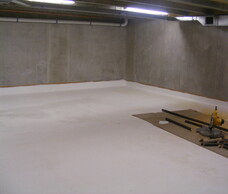Waterproofing
Keeping Water Out or In
Stratmore manufactures and distributes products to make structures waterproof, repel water or keep water in.
Products for concrete and masonry substrates.
Product
AQUELLA
AQUELLA is an inorganic powder based on white cement with a hardening accelerator, mixed with water and applied to the inside of damp walls and floors to prevent the passage of water and moisture. AQUELLA unites with the substrate to form a surface which is watertight from both sides and sets rock hard with age.
What's it used for?
The chief application for AQUELLA is for waterproofing internal subgrade walls and floors as found in basements, tunnels, lift wells etc. AQUELLA is also used to seal floors without or with damaged damp courses prior to laying carpet or tiles. AQUELLA can also be used internally or externally on tanks and water retaining structures.
What can it be applied to?
It can be used on the following surfaces: brick, concrete, mortar, cement rendering, breeze blocks, stucco, stone, terracotta tiles (roughened), fish tanks (fill and rinse three times before introducing fish).
Coverage: 1 – 1.5m²/kg (surface dependent)
Limitations
Is not suitable for: gypsum plaster, metals, timber, silicone treated surfaces, bituminous surfaces, whitewashed surfaces, painted surfaces and other coated surfaces. Not suitable for application to substrates subject to wear such as garages, trafficked areas, etc without covering.
Product
CONCRETE BLOCK SEALER
CONCRETE BLOCK SEALER is a clear, high solids, low VOC waterborne sealer, which when used as part of a complete system, is effective in sealing porous masonry such as concrete blocks, and acts by blocking the pores against water ingress while not changing the appearance of the substrate to any significant extent. CONCRETE BLOCK SEALER has excellent weathering, UV and yellowing resistance.
CONCRETE BLOCK SEALER, when applied as part of the complete system (including AQUELLUX S WB), easily exceeds the requirements of CCANZ CP 01:2022 Code of Practice for Weathertight Concrete and Concrete Masonry Construction, section 4.4 Clear Coating System, when tested in accordance with AS/NZS 4456.16:2003 “Determining Permeability to Water" (tested by Opus International Consultants Limited).
What's it used for?
CONCRETE BLOCK SEALER is recommended for use on all masonry, especially highly porous masonry such as concrete blocks, to seal against the ingress of water. It is especially suited to vertical surfaces and will not sag if applied at the recommended spreading rate. Once cured, it forms a non-absorbent clear coating which resists water and will not blanch when wet.
What can it be applied to?
CONCRETE BLOCK SEALER may be used on all types of concrete and uncoated timber. It is recommended for masonry concrete block and may be applied externally and internally.
Coverage:
1st Coat: 2 – 4m²/L (surface dependent)
2nd Coat: 6 – 8m²/L (surface dependent)
3rd Coat: 10 – 12m²/L (surface dependent)
Limitations
CONCRETE BLOCK SEALER is not designed for use in areas subject to excessive wear and tear. It is not recommended for use on plastics or metals. CONCRETE BLOCK SEALER is not suitable for any below grade application or tanking application.
Application of the CONCRETE BLOCK SEALER SYSTEM is to be undertaken by an approved applicator that is a member of the NZ Master Painters Association or as otherwise approved by Stratmore Construction Solutions in writing.
Product
PROTECTA-COAT
PROTECTA-COAT is a clear high solids, low VOC waterborne sealer, which when used as part of a complete system, is effective in sealing porous masonry such as concrete blocks, and acts by blocking the pores against water ingress while not changing the appearance of the substrate to any significant extent. PROTECTA-COAT has excellent weathering, UV and yellowing resistance.
What's it used for?
PROTECTA-COAT is recommended for use on all masonry, especially highly porous masonry such as concrete blocks, to seal against the ingress of water. It is especially suited to vertical surfaces and will not sag if applied at the recommended spreading rate. Once cured, it forms a non-absorbent clear coating which resists water and will not blanch when wet.
PROTECTA-COAT is applied to substrates that do not require compliance with the CCANZ CP 01:2022 Code of Practice for Weathertight Concrete and Concrete Masonry Construction, section 4.4 Clear Coating System.
What can it be applied to?
PROTECTA-COAT may be used on all types of concrete and uncoated timber. It is recommended for masonry concrete block and may be applied externally and internally.
Coverage:
1st Coat: 2 – 4m²/L (surface dependent)
2nd Coat: 6 – 8m²/L (surface dependent)
3rd Coat: 10 – 12m²/L (surface dependent)
Limitations
PROTECTA-COAT is not designed for use in areas subject to excessive wear and tear. It is not recommended for use on plastics or metals. PROTECTA-COAT is not suitable for any below grade application or tanking application.
Product
KRYSTOL T1
Krystol T1 is a surface applied crystalline slurry treatment that transforms new or existing concrete into a permanent waterproof barrier. Krystol T1 lowers the permeability of the concrete to protect against the ingress of water and waterborne chemicals. Since it becomes integral to the concrete, it can be applied to either the positive (wet) or negative (dry) side of the water pressure which allows reliable hydrostatic waterproofing protection and remediation for even the most difficult applications.
How it Works
Krystol T1 contains Krystol technology. When applied to concrete, Krystol chemically reacts with water and un-hydrated cement particles to form needle-shaped crystals that fill capillary pores and micro-cracks in the concrete and permanently block the pathways for water and waterborne contaminants. Any moisture introduced over the lifespan of the concrete will initiate crystallization, ensuring permanent waterproofing protection.
What can it be applied to?
Krystol T1 can be used to waterproof the following structures:
Concrete basements, walls, slabs, footings
Marine structures
Elevator pits and equipment pits
Parking structures
Swimming pools and water features
Water towers, reservoirs and storage tanks
Tunnels, pipes and underground vaults
Water treatment reservoirs
Bridge decks, elevated slabs and ramps
Rooftops and roof decks
Coverage:
1.2 – 1.6kg/m² (depending on two coat or single coat application)
Limitations
Krystol T1 Concrete Waterproofing is an effective waterproofing system for rigid concrete structures only and may not be reliable for structures with unstable, moving cracks or joints.
Cementitious coatings, including plaster, must either have a bonding aid incorporated or the Krystol T1 coating be primed with a bonding aid prior to overcoating with the coating.
Product
AQUELLUX S
AQUELLUX S is a state-of-the-art siloxane water repellent which is used to make porous building materials water repellent without changing their appearance. The active component used in the manufacture of AQUELLUX S is made by a world leader in water repellent technology. Siloxane water repellents are used to protect all motorway bridges in Sweden from damage caused by salt and freezing weather in the European winter; as well as being used to protect many important historical buildings throughout Europe and the USA.
What's it used for?
AQUELLUX S is used to treat vertical and inclined exterior surfaces such as walls and roofs. AQUELLUX S is effective in hairline cracks up to 0.3mm wide. AQUELLUX S is applied to surfaces to minimise and help protect against the following:
Leakage and dampness.
Spalling due to frost or freezing.
Efflorescence and leaching of salts.
Growth of moss, lichen and mildew.
Corrosion due to waterborne chemicals.
Reduced thermal insulation due to dampness.
Surface degradation caused by penetration of waterborne dirt and soil.
What can it be applied to?
Materials suitable for treatment with AQUELLUX S include concrete, cement plaster, blockwork, bricks, roofing tiles, cement asbestos and fibrous cement, GRC panels and natural stone.
Coverage:
As a guide
Concrete blocks and porous stone: max 1m²/L
Normal concrete: 2 – 3m²/L
Dense concrete and brick: up to 6m²/L
Limitations
AQUELLUX S is not suitable for use on horizontal surfaces (and inclined surfaces where ponding may occur), surfaces exposed to water pressure such as tank walls or building foundations, excessively porous surfaces, previously painted surfaces or below grade surfaces. It is not to be used on substrates with cracks above 0.3mm wide or in poor condition. Oamaru stone and concrete blocks are very porous surfaces and AQUELLUX S must be applied at a minimum rate of 1 litre per 1m² of substrate.
Do NOT allow AQUELLUX S to contact glass, aluminium or substrates not to be made water repellent.
Product
AQUELLUX S WB
AQUELLUX S WB is a water-based, solvent-free silane/siloxane water repellent applied to porous building materials to make them water repellent without changing their appearance.
What's it used for?
AQUELLUX S WB is used to treat vertical and inclined concrete surfaces such as walls and roofs. AQUELLUX S WB is effective in hairline cracks up to 0.3 mm wide. Used to increase protection from: Leakage and dampness. Spalling due to frost or freezing. Efflorescence and leaching of salts. Penetration of dirt, rust etc. A reduction in growth of moss, lichen and mildew due to reduced surface moisture. Corrosion due to waterborne chemicals.
AQUELLUX S WB is also used as a primer for CONCRETE BLOCK SEALER and PROTECTA-COAT.
What can it be applied to?
Limitations
Not suitable for use on surfaces exposed to water pressure such as tank walls and horizontal surfaces subject to ponding, previously painted surfaces and highly porous substrates. It is also not as effective on dense natural surfaces such as limestone and marble. For Oamaru stone, use SILAC or AQUELLUX S.
Do NOT allow AQUELLUX S WB to contact glass, aluminium or substrates not to be made water repellent.
Product
SILAC
SILAC is an acrylic modified silicone water repellent used to render porous exterior building materials water repellent, especially Oamaru stone. Water absorption into the building material is stopped or greatly reduced, while water within the material is still able to evaporate out.
When applied, SILAC penetrates into the surface sealing smaller pores and lining the larger pores and capillaries with a water repellent resin.
What's it used for?
SILAC is generally used to render vertical and inclined surfaces, such as walls and roofs, water repellent. It has been used successfully on cracked horizontal surfaces such as balconies as a remedial water repellent.
Due to the acrylic content of SILAC, it is capable of sealing surfaces which are too porous for treatment with normal water repellents.
What can it be applied to?
Materials suitable for treatment with SILAC include concrete, cement plaster, blockwork, bricks, roofing tiles, fibrous cement and natural stone.
SILAC is very effective on Oamaru stone helping to maintain a clean and water-repellent surface and preventing degradation.
Coverage:
As a guide
Concrete blocks and porous stone: max 1m²/L
Normal concrete: 2 – 3m²/L
Dense concrete and brick: up to 4m²/L
Limitations
SILAC is not suitable for use on horizontal surfaces (and inclined surfaces where ponding may occur), surfaces exposed to water pressure such as tank walls or building foundations, excessively porous surfaces, previously painted surfaces or below grade surfaces. It is not to be used on substrates with cracks above 0.3mm wide or in poor condition. Oamaru stone is a very porous surfaces and SILAC must be applied at a minimum rate of 1 litre per 1m² of substrate.
Do NOT allow SILAC to contact glass, aluminium or substrates not to be made water repellent.
Information presented on this website must be read in conjunction with the latest technical datasheet, product label and any other application data.
Click here to download technical data





